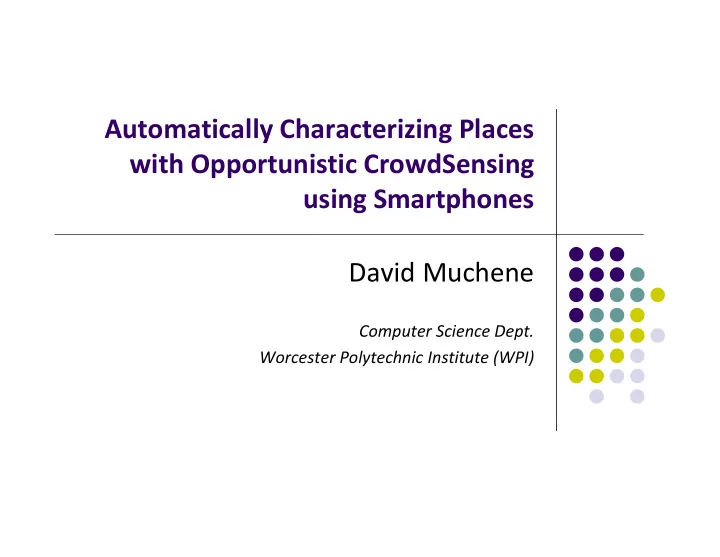

Automatically Characterizing Places with Opportunistic CrowdSensing using Smartphones David Muchene Computer Science Dept. Worcester Polytechnic Institute (WPI)
Introduction Smart phones have a variety of new sensors Location is still the most widely used contextual information in most applications Need to abstract out the notion of “place” from location data
Contributions CrowdSense@place (CSP) A framework that characterizes places using opportunistically acquired images and audio Basic idea is that Images contain hints and CSP can extract these hints and use them in the classification Classify into more categories than current approaches A novel modeling approach that combines image, audio, and traditional location sensors
Existing Approaches Discover places by mining user’s trajectory Label discovered places (e.g. mall, drug store) Either User input, or by leveraging databases like Bing, Yelp or FourSquare Problem is that GPS/WiFi location estimates could have large margins of error GPS is especially terrible indoors
System Overview Smart phone App and a offline server to process collected data App runs as a daemon and continually fingerprints WiFi Access points to detect places Opportunistically sample image and audio sensor For example when a user receives a phone call Bootstrap the image and audio classifications using user input.
System Overview Indoor Scene Classification Object recognition OCR Speech Recognition Place modeling
System Overview
Evaluation Recruited 36 users living in 5 locations Measured accuracy of place categorizations Used GPS data and Mobility GPS data is fed into FourSquare Mobility uses trajectory to do place classification Client was implemented using Android SDK 1.5 Backend on Microsoft Azure
Results
Future Work and Conclusions Finer place classification Better use of the object and speech recognition Privacy Perform more local computation to avoid leaking private information Applications Better Local search, recommendations, targeted advertising, etc. Understand large scale behavior patterns to gain insights about cities
References Automatically characterizing places with opportunistic crowdsensing using smartphones . Yohan Chon, Nicholas D. Lane, Fan Li, Hojung Cha, and Feng Zhao
Recommend
More recommend